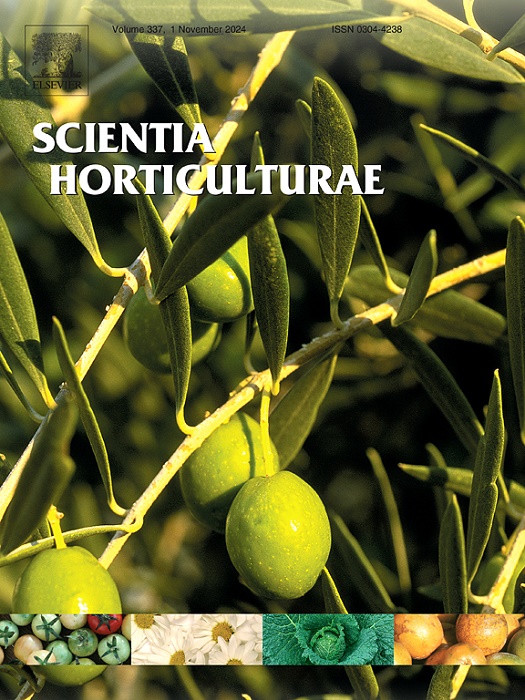葡萄和覆盖作物的光谱响应评价葡萄园的时空变异
IF 3.9
2区 农林科学
Q1 HORTICULTURE
引用次数: 0
摘要
在葡萄园中使用覆盖作物被认为是一种有助于改善土壤结构的管理策略。覆盖作物的遥感技术提供了空间变异性的信息,可用于精确的葡萄栽培。本研究旨在利用2021-2022年期间测量的生物特征数据、光谱响应和土壤理化参数,研究土壤-植物相互作用,评估覆盖作物和葡萄园的时空变化。这些评估是在一个半干旱的地中海环境中的一个农场葡萄园进行的。在冬季(T1),对覆盖作物(蚕豆)的生长进行了评价。同样,在夏季(T2),在开花(T2A)和葡萄成熟(T2B)的物候阶段对葡萄园进行监测。利用无人机(UAV)获取的多光谱图像,计算归一化植被指数(NDVI),得到作物活力图。通过双变量LISA聚类图,将覆盖作物活力图与葡萄园活力图进行比较,发现两种作物之间存在显著的正空间自相关。事实上,在覆盖作物干物质积累较高的地区,葡萄藤生长旺盛。考虑土壤参数,对T1和T2调查中发现的空间关联进行了检验。结果表明,在覆盖作物和藤蔓植被NDVI均较高的地区,土壤有机碳(SOC)和全氮(TN)等土壤因子较高。相反,在两种作物NDVI值较低的地区,它们与较高的土壤容重(BD)相关。此外,在低活力区,在T1和T2均观察到较高的土壤穿透阻力(SPR)值,这有助于限制根系伸长,从而降低作物的整体生长。利用主成分分析(PCA)评价土壤理化性质和活力图观测到的植被生长变异性。在这些组成部分中考虑的土壤参数强调了它们对作物生长的影响。本研究强调土壤因子对作物时空变异性的直接影响。监测覆盖作物可以早期发现空间变化,支持葡萄种植者选择可持续的葡萄园管理技术。本文章由计算机程序翻译,如有差异,请以英文原文为准。
Grapevine and cover crop spectral response to evaluate vineyard spatio-temporal variability
The use of cover crops in vineyards is considered a management strategy that contributes to improving soil structure. Remote sensing techniques of cover crops provide information on spatial variability that can be useful in precision viticulture. This study aims to investigate soil-plant interactions using biometric data, spectral response and soil physico-chemical parameters measured across 2021–2022, with the scope of assessing spatio-temporal variations of cover crop and vineyard. These evaluations were conducted on an on-farm vineyard in a semi-arid Mediterranean environment. During the winter season (T1), the cover crop (Vicia Faba) growth was evaluated. Equally, during the summer season (T2), vineyard monitoring was carried out during the phenological stages of flowering (T2A) and grape ripening (T2B). Multispectral images acquired through unmanned aerial vehicle (UAV) were employed, and subsequently, the normalized difference vegetation index (NDVI) was calculated to obtain crops vigor maps. Through bivariate LISA cluster maps, cover crop vigor maps were compared with those of the vineyard, revealing the presence of significant positive spatial autocorrelation between the two crops. Indeed, in areas where the cover crop exhibited higher dry matter accumulation, grapevine high vigor growth was observed. The spatial association identified in surveys conducted in T1 and T2 was examined considering soil parameters. It emerged that in areas where both the cover crop and the vines exhibited high NDVI values, soil factors such as soil organic carbon (SOC) content and total nitrogen (TN) were higher. Conversely, in areas where both crops showed low NDVI values, they were associated with higher soil bulk density (BD). Moreover, in low vigor zones, higher soil penetration resistance (SPR) values were observed in both T1 and T2, contributing to limiting root elongation and thus reducing overall crop growth. Vegetative growth variability observed through vigor maps and soil physicochemical properties was evaluated through principal component analysis (PCA). Soil parameters considered within these components highlighted their influence on crop growth. This study emphasizes how soil factors directly influence the spatiotemporal variability of crops. Monitoring cover crops allows for early detection of spatial variability, supporting vine growers in choosing sustainable vineyard management techniques.
求助全文
通过发布文献求助,成功后即可免费获取论文全文。
去求助
来源期刊

Scientia Horticulturae
农林科学-园艺
CiteScore
8.60
自引率
4.70%
发文量
796
审稿时长
47 days
期刊介绍:
Scientia Horticulturae is an international journal publishing research related to horticultural crops. Articles in the journal deal with open or protected production of vegetables, fruits, edible fungi and ornamentals under temperate, subtropical and tropical conditions. Papers in related areas (biochemistry, micropropagation, soil science, plant breeding, plant physiology, phytopathology, etc.) are considered, if they contain information of direct significance to horticulture. Papers on the technical aspects of horticulture (engineering, crop processing, storage, transport etc.) are accepted for publication only if they relate directly to the living product. In the case of plantation crops, those yielding a product that may be used fresh (e.g. tropical vegetables, citrus, bananas, and other fruits) will be considered, while those papers describing the processing of the product (e.g. rubber, tobacco, and quinine) will not. The scope of the journal includes all horticultural crops but does not include speciality crops such as, medicinal crops or forestry crops, such as bamboo. Basic molecular studies without any direct application in horticulture will not be considered for this journal.
 求助内容:
求助内容: 应助结果提醒方式:
应助结果提醒方式:


